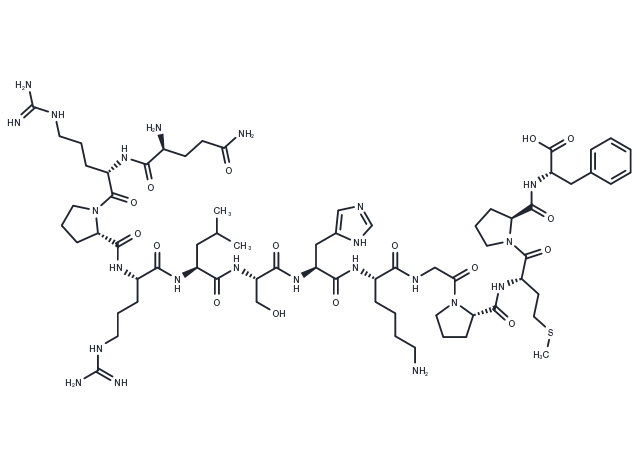store at low temperature,keep away from moisture
Powder: -20°C for 3 years | In solvent: -80°C for 1 year

Apelin-13 is a 13-amino acid peptide sequence found in the central and peripheral nervous system that is an endogenous ligand for the G protein-coupled receptor angiotensin II protein J (APJ), with an EC50 value of 0.37 nM for APJ.Apelin-13 has vasodilatory and antihypertensive activity and can be used to study type 2 diabetic syndrome. Apelin-13 has vasodilatory and antihypertensive activities and can be used to study type 2 diabetes syndrome.

| Pack Size | Availability | Price/USD | Quantity |
|---|---|---|---|
| 1 mg | In stock | $ 47.00 | |
| 5 mg | In stock | $ 150.00 | |
| 10 mg | In stock | $ 257.00 | |
| 25 mg | In stock | $ 463.00 | |
| 50 mg | In stock | $ 694.00 |

| Description | Apelin-13 is a 13-amino acid peptide sequence found in the central and peripheral nervous system that is an endogenous ligand for the G protein-coupled receptor angiotensin II protein J (APJ), with an EC50 value of 0.37 nM for APJ.Apelin-13 has vasodilatory and antihypertensive activity and can be used to study type 2 diabetic syndrome. Apelin-13 has vasodilatory and antihypertensive activities and can be used to study type 2 diabetes syndrome. |
| Targets&IC50 | APJ:0.37 nM |
| In vitro | In cultured PC12 cells, the same protective effects were also observed.?Silencing Nrf2 gene with its siRNA abolished the Apelin 13's prevention of I/R-induced PC12 cell injury, oxidative stress, and inflammation.?Inhibition of AMPK by its siRNA decreased the level of Apelin 13-induced Nrf2 expression and diminished the protective effects of Apelin 13.?The interplay relationship between GSK-3β and Nrf2 was also verified with relative overexpression.?Using selective inhibitors, we further identified the upstream of AMPK/GSK-3β/Nrf2 is AR/Gα/PLC/IP3/CaMKK. |
| In vivo |
Administered intraperitoneally at a daily dosage of 200 µg/kg for 4 weeks, Apelin-13 improves cardiac function, insulin resistance, and lipid metabolism. It significantly decreases serum levels of TNF-α and leptin, induces the expression of Apelin-12 in serum, and markedly elevates levels of GLUT4 and p-AMPKα2[2]. When delivered via intracerebroventricular injection at single dosages of 10 and 100 μM, Apelin-13 increases the spontaneous discharges in the majority of pallidal neurons[3]. |
| Cell Research | For in vitro study, PC12 cells were used,proteases inhibitors or siRNA were used.?Protein levels were investigated by western blotting. |
| Animal Research | In vivo, the I/R model was induced and Apelin 13 was given intracerebroventricularly 15 min before reperfusion.?The neurobehavioral scores, infarction volumes, and some cytokines in the brain were measured. |
| Molecular Weight | 1550.83 |
| Formula | C69H111N23O16S |
| CAS No. | 217082-58-1 |
store at low temperature,keep away from moisture
Powder: -20°C for 3 years | In solvent: -80°C for 1 year
H2O: 50 mg/mL (32.24 mM), Sonication is recommended.
DMSO: 50 mg/mL (32.24 mM), Sonication is recommended.
You can also refer to dose conversion for different animals. More
bottom
Please see Inhibitor Handling Instructions for more frequently ask questions. Topics include: how to prepare stock solutions, how to store products, and cautions on cell-based assays & animal experiments, etc.
Apelin-13 217082-58-1 inhibit Inhibitor Apelin Receptor (APJ) nervous systems antihypertensive metabolic syndrome Apelin13 diabetes Goto-Kakizaki rat insulin resistance pallidal neurons lipid Apelin 13 Wistar rat vasodilatory inhibitor
